Miraglossum davyi
Miraglossum davyi (N.E. Br.) Kupicha
Family: Apocynaceae
Common names: No known common names.
Introduction
Miraglossum davyi is indeed an astonishing plant when viewed close-up. The remarkable structure of the corona lobes of this rarely seen plant has been described as "five children with outspread hands joined in a ring and dancing around a table" or "resembles the head of an African elephant"; the tips elongated into a slender upturned 'trunk' and the lateral sides deepened and widened into 'ears'.
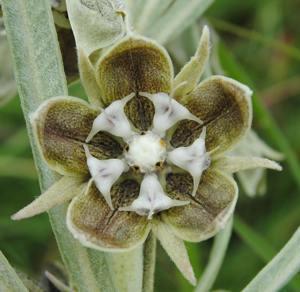
Description
Description
This is a perennial geophytic herb with a deep-seated, cylindrical and elongated tuber. Plants are usually unbranched. Aerial parts are deciduous, all parts with milky latex. Stems are 320 - 610 mm tall, with long interwoven woolly hairs (lanate).
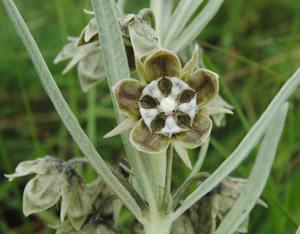
Leaves are also lanate, crowded and irregularly inserted below, becoming whorled in the section with flowers; blade 24 - 52 × 3 - 6 mm, sword-shaped with a sharp tip, margins strongly rolled with a ±2 mm long pedicel.
Flowers are grey-green paler on outside, inside darker with brown to maroon blotches in longitudinal stripes sometimes alternating with some white stripes, in sessile groups of 3 - 4 at the nodes where they are borne. Corolla more than 20 mm in diameter, lobes flat and spreading, with a hairy mix of sharp hyaline and brown hairs; oval to lance-shaped, pale green outside and darker green inside with maroon to brown blotches or longitudinal striations or sometimes homogeneously green. Corona fleshy with a complex structure, usually white with minute purple spots. Pollen aggregated in a pollinarium with winged clip (corpuscle). Flowering time is from November to January (mainly in December and January).
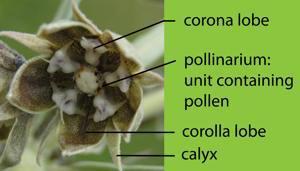
Fruit to 80 × 10mm, covered with bristles and dense white indumentum.
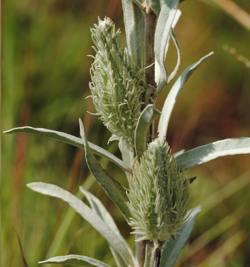
Conservation Status
Status
This is an extremely localised species. In its last assessment, the taxon was listed as vulnerable (VU) on the Red List of South African plants. This status is probably more the result of the threatened habitat than the rarity of the plants itself. It is, however, restricted to the grasslands on the plateau above the eastern escarpment of Mpumalanga in the Highveld. This status is based on the small number of known populations and declining nature of the species as a result of habitat loss to coal mining, urban expansion and agriculture.

Its natural environment is heavily impacted on by agriculture and cattle farming.
Miraglossum davyi is a very rare plant - measured by the few herbarium specimens, it seems that populations have a low rate of producing fruit.
Distribution and habitat
Distribution description
The entire genus Miraglossum is restricted to southern Africa. Miraglossum davyi is endemic to the Mpumalanga Province (Dullstroom, Middelburg and Standerton areas) in South Africa.
The plants grow in open, gentle sloping grassland of high altitudes on sand or heavy black loam soils in areas that are prone to very low temperatures, frost and even snow in winter.
Derivation of name and historical aspects
History
The Latin words mirus/mirari (to wonder or be astonished at) and glossa (tongue) were combined to form the generic name, which aptly describes the astonishing corona lobes of most of the species in this genus.
Burtt Davy is honoured in the specific epithet used for the name. He was a prolific plant collector in South Africa in the early 1900s and first curator of the National Herbarium in Pretoria (PRE) which today houses about 6 000 of the more than 14 000 specimens he collected during his career.
The genus Miraglossum currently consists of seven species. Miraglossum davyi is the most distinct and largest-flowered member in the genus. The genus is closely related to the genera Aspidoglossum and Schizoglossum.
The only other Miraglossum species that occur in the same habitat with M . davyi is M . pulchellum, which is the widest distributed species of the genus.
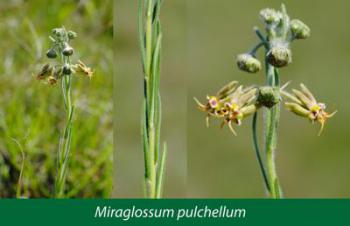
The rarer M . laeve is evolutionary the closest related to M . davyi (at least in terms of the shape of the corona lobes) and grows in the Potchefstroom district (North-West Province), some 300km southwest from the nearest M . davyi populations.
Ecology
Ecology
This is a montane species found at 1700 - 2076 m altitude. Production of fruit and seed set are rarely seen. No pollinators have been observed visiting these plants. Plants usually grow in annually burnt grassland. These fires usually occur at the end of winter and the smoke and heat probably stimulate plants to resprout in springtime.
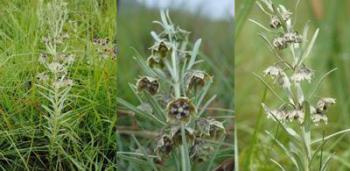
Uses
Use
It is not known if this plant has any specific uses (cultural or medicinal).
The low fruit and seed set and structure of tuber does not render it a subject for potential horticultural prospects. With its difficult nature, even collectors that have a lot of experience in growing difficult plants may find it challenging to grow this species successfully. It is thus better left in nature and appreciated in its natural environment.
Growing Miraglossum davyi
Grow
This genus and its closely related genera (Aspidoglossum, Cordylogyne, Periglossum, Schizoglossum and Stenostelma ) are extremely difficult to cultivate. Plants grown from the wild usually have a very low success rate because of their 'dry' tubers that make transplanting them extremely difficult.
Plants cannot be found in nurseries but may have the best chances when grown from seed. Plants naturally grow in well-drained to moist or damp gravelly to humic or black clayey soils with a high organic content in full sun at high altitudes with low temperatures in winter. The simulation of these growth conditions will probably give the best results when trying to grow plants from seed.
Fruit ripens in mid summer and seeds are distributed and possibly only germinate in the next growing season after winter.
Fruits are prone to infestations of especially woolly aphids. This, coupled with the possible absence of successful pollinators, may have led to the decline in population size and needs further investigation.
References
- Bester, S.P. & G. Condy. 2013. Miraglossum davyi . Flowering Plants of Africa 63: 138-144, t. 2300.
- Germishuizen, G. & Fabian, A. 1997. Wildflowers of northern South Africa . Fernwood Press.
- Glen, H.F. & Germishuizen, G. (compilers) 2010. Botanical exploration of southern Africa, edition 2. Strelitzia 26. South African National Biodiversity Institute, Pretoria.
- Kupicha, F.K. 1984. Studies on African Asclepiadaceae. Kew Bulletin 38: 599-672.
- Lötter, M., Burrows, J.E., Nicholas, A. & Victor, J.E. 2005. Miraglossum davyi (N.E.Br.) Kupicha. National Assessment: Red List of South African Plants version 2013.1. Accessed on 2013/07/08
- Pooley, E. 2005. A field guide to wild flowers of KwaZulu-Natal and the Eastern Region. Natal Flora Publication Trust, Durban.
- Retief, E. & Herman, P.P.J. 1997. Plants of the northern provinces of South Africa: keys and diagnostic characters . Strelitzia 6. National Botanical Institute, Pretoria.
- Victor, J.E., Bredenkamp, C.L., Venter, H.J.T., Bruyns, P.V. & Nicholas, A. 2000. Apocynaceae. In O.A. Leistner, Seed plants of southern Africa: families and genera. Strelitzia 10: 71-98. National Botanical Institute, Pretoria.
Credits
S.P. Bester
National Herbarium (PRE)
August 2013
Plant Attributes:
Plant Type: Bulb, Perennial
SA Distribution: Mpumalanga
Soil type: Loam, Metal-rich
Flowering season: Early Summer
PH:
Flower colour: Green, White, Cream
Aspect: Full Sun
Gardening skill:
Special Features:
Horticultural zones







Rate this article
Article well written and informative
Rate this plant
Is this an interesting plant?
Login to add your Comment
Back to topNot registered yet? Click here to register.